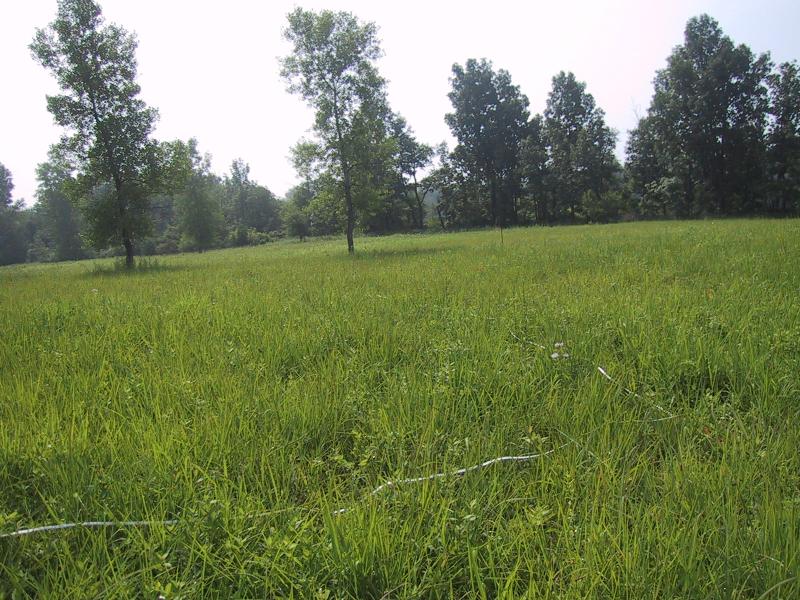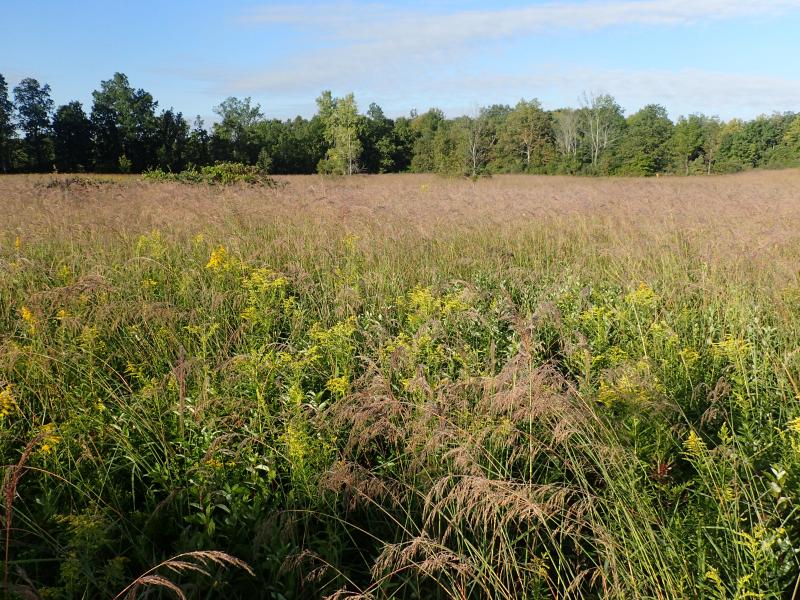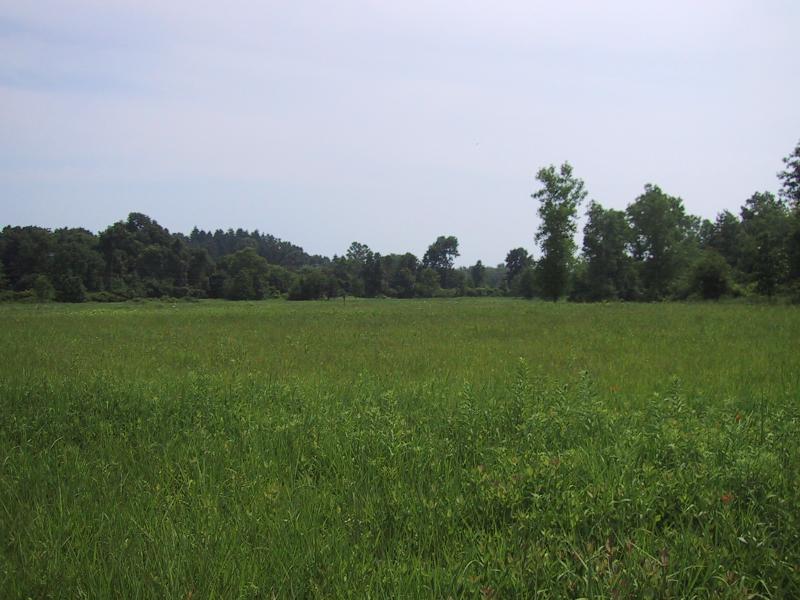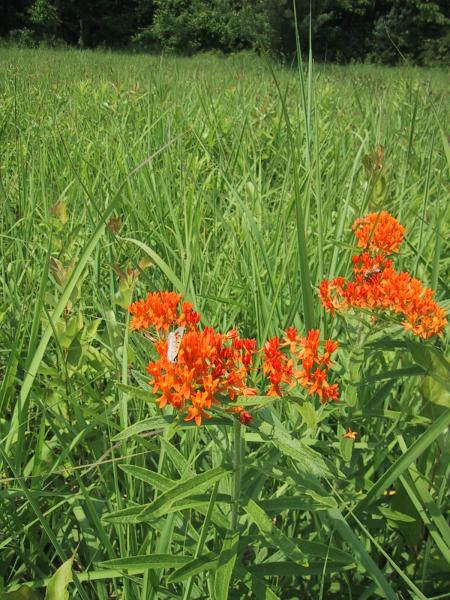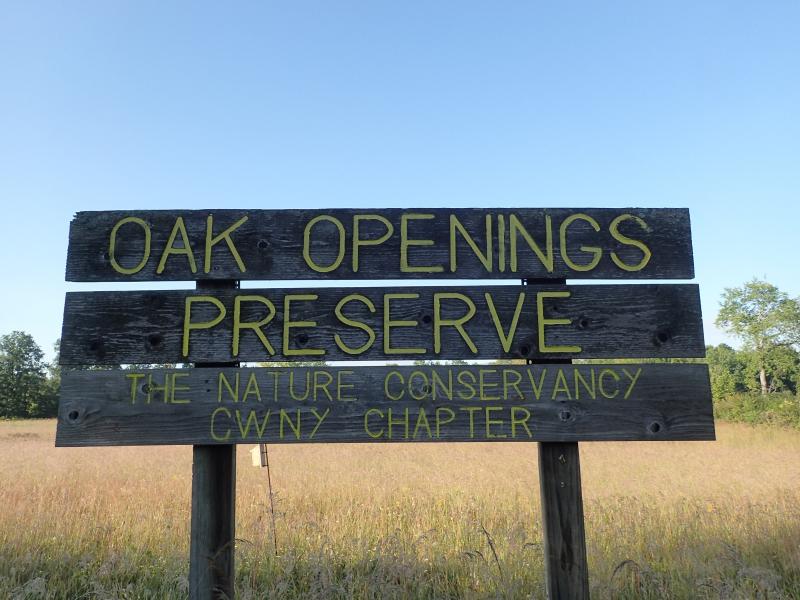Oak Openings
- System
- Terrestrial
- Subsystem
- Barrens And Woodlands
- State Protection
- Not Listed
Not listed or protected by New York State.
- Federal Protection
- Not Listed
- State Conservation Status Rank
- S1
Critically Imperiled in New York - Especially vulnerable to disappearing from New York due to extreme rarity or other factors; typically 5 or fewer populations or locations in New York, very few individuals, very restricted range, very few remaining acres (or miles of stream), and/or very steep declines.
- Global Conservation Status Rank
- G2
Imperiled globally - At high risk of extinction due to rarity or other factors; typically 20 or fewer populations or locations in the world, very few individuals, very restricted range, few remaining acres (or miles of stream), and/or steep declines.
Summary
Did you know?
Oak openings, or grass-savanna openings within oak-hickory matrix forests, were never very common in New York. Far more common in the midwestern United States, this community type has declined dramatically throughout its range due to a combination of fire suppression, land development, and competition by invasive species. Widespread fire suppression has led to the succession of nearly all oak openings to mature forest. Historically, oak openings were created through the dynamics of natural fire disturbance; as openings succeeded to woody vegetation, regular fires in the landscape prevented canopy closure and dominance by woody vegetation.
State Ranking Justification
This community has been degraded or destroyed throughout its range. New York State is at the edge of the range of the community. There are less than five occurrences statewide, and probably not many more historically given that its range is primarily restricted to the Monroe County portion of the Eastern Ontario Till Plain. Although two documented occurrences have good viability, there are no high quality examples known in the state (i.e., no A- to AB-ranked occurrences). Only two oak openings are protected on public land or private conservation land. The current trend of this community is declining moderately as a result of invasive species, development, and recreational overuse.
Short-term Trends
The number and acreage of oak openings in New York have declined in recent decades as a result of displacement by development and the spread of invasive species. At least two occurrences first documented in the mid-1980s have been lost. This loss has been offset somewhat by restoration efforts at Rush Oak Openings.
Long-term Trends
The number and acreage of oak openings in New York have probably declined moderately from historical numbers as a result of fire suppression, conversion to agriculture, and other development. Oak openings were probably always few in number and small in size in New York.
Conservation and Management
Threats
Invasive plants are the primary threat to all oak openings in New York. Various species of black swallow-wort (Cynanchum spp.) are having an alarming impact. Other invasive species include shrubby honeysuckle (Lonicera morrowii) and various pasture weeds. Suppression of the natural fire regime is the second greatest threat to this community. Oak openings are also threatened by development (e.g., residential, agricultural, roads, etc.) and recreational overuse (e.g., ATVs, mountain bikers, and hikers). Logging and trash dumping are considered minor threats to a few examples of this community.
Conservation Strategies and Management Practices
This community needs to be kept open, either by mechanical means (e.g., brush-hogging) or prescribed burning to reduce woody plant invasion. Monitor and control invasive species, especially pale swallow-wort (Cynanchum spp.) and buckthorn (Rhamnus cathartica).
Development and Mitigation Considerations
Soils are very thin in and around this community, and the effects of clearing and construction on soil retention and erosion must be considered during any development activities. Similarly, these soils are acidic and nutrient-poor, and any soil enrichment (e.g., septic leach fields, fertilized lawns, etc.) activities have a high probability of altering community structure and function. The open structure of this community is maintained by fire and presents a fire hazard to existing and proposed development. Unprotected structures located within or near this community are more susceptible to damage from fire.
Inventory Needs
Inventory oak openings beyond Monroe County in order to resolve questionable identifications. Survey areas predicted by distribution modeling efforts (e.g., northeast Ontario County).
Research Needs
Compare New York sites with larger, more intact examples in the Midwest to confirm classification and rarity.
Rare Species
- Carex meadii (Mead's Sedge) (guide)
- Carex mesochorea (Midland Sedge) (guide)
- Carex molesta (Troublesome Sedge) (guide)
- Carex richardsonii (Richardson's Sedge) (guide)
- Chordeiles minor (Common Nighthawk) (guide)
- Cyperus schweinitzii (Schweinitz's Flat Sedge) (guide)
- Desmodium ciliare (Hairy Small-leaved Tick Trefoil) (guide)
- Desmodium obtusum (Rigid Tick Trefoil) (guide)
- Draba arabisans (Rock Whitlow Grass) (guide)
- Lasiurus borealis (Eastern Red Bat) (guide)
- Lasiurus cinereus (Hoary Bat) (guide)
- Myotis lucifugus (Little Brown Bat) (guide)
- Valerianella chenopodiifolia (Goosefoot Cornsalad) (guide)
Range
New York State Distribution
This community is currently known from the Erie and Ontario Lake Plain with most sites occurring within the Monroe County portion of the Eastern Ontario Till Plain. The historical range was probably restricted to the same area, and probably extended east into Wayne and Ontario counties, south into Livingston County, and west to Niagara and Erie counties.
Global Distribution
This community occurs in the upper midwestern United States and possibly adjacent Canada, particularly in south-central Michigan and western New York, and possibly southern Ontario.
Best Places to See
- Rush Oak Openings Unique Area (Monroe County)
Identification Comments
General Description
Oak openings are grass-oak savanna communities that occur on well-drained soils. In New York, these savannas originally occurred as openings within extensive oak-hickory forests. Historically they were restricted to exessively well-drained sites such as on knobs or hilltops with shallow soil over dolomite outrcrops, sandy to gravelly soils of kames and eskers, or gravelly glacial deltas and terraces. The best remnants can be found on dolomite knobs. Characteristic trees include Chinquapin oak (Quercus muehlenbergii), white oak (Q. alba), and black oak (Q. velutina). The oaks occur as open-grown trees with broadly spreading canopies and are sparsely distrubuted across a graminoid groundlayer dominated by warm-season grasses.
Characters Most Useful for Identification
Oak openings are a fire-dependent, savanna community type that is dominated by oaks that are typically scattered amongst a predominantly graminoid ground layer. Canopy cover in oak openings ranges from 0-60% cover, with or without a shrub layer. An abundance of fire dependent warm season grasses including Indian grass (Sorghastrum nutans), little bluestem (Schizachyrium scoparium), and big bluestem (Andropogon gerardii) can help identify oak openings, along with the presence of large, open grown oaks, especially Chinquapin oak, white oak, black oak, and possibly bur oak (Quercus macrocarpa).
Elevation Range
Known examples of this community have been found at elevations between 410 feet and 705 feet.
Best Time to See
The best time to experience oak openings is during the summer months, from June to August, when a variety of wildflowers, insects, and birds can be seen in and around the openings. The bright orange flower of butterfly milkweed (Asclepias tuberosa) is attractive to monarch butterflies, hummingbirds, and a number of other insects. Eastern bluebirds nest in cavity trees around the openings and the largest openings are used by a number of other openland bird species including savanna sparrow, eastern meadowlark, American kestral, and brown thrasher.
Oak Openings Images
Classification
International Vegetation Classification Associations
This New York natural community encompasses all or part of the concept of the following International Vegetation Classification (IVC) natural community associations. These are often described at finer resolution than New York's natural communities. The IVC is developed and maintained by NatureServe.
- White Oak - Bur Oak / Big Bluestem Open Woodland (CEGL005121)
NatureServe Ecological Systems
This New York natural community falls into the following ecological system(s). Ecological systems are often described at a coarser resolution than New York's natural communities and tend to represent clusters of associations found in similar environments. The ecological systems project is developed and maintained by NatureServe.
- North-Central Interior Oak Savanna (CES202.698)
Characteristic Species
-
Trees > 5m
- Carya ovata var. ovata (shagbark hickory)
- Quercus alba (white oak)
- Quercus muehlenbergii (yellow oak, chinquapin oak)
-
Shrubs 2 - 5m
- Cornus racemosa (gray dogwood, red-panicled dogwood)
- Viburnum dentatum var. lucidum (smooth arrowwood)
-
Shrubs < 2m
- Cornus racemosa (gray dogwood, red-panicled dogwood)
- Lonicera morrowii (Morrow's honeysuckle)
- Rubus flagellaris (northern dewberry)
- Viburnum dentatum var. lucidum (smooth arrowwood)
-
Herbs
- Anemone canadensis (Canada anemone)
- Antennaria neglecta (field pussy-toes)
- Asclepias tuberosa (butterfly-weed)
- Daucus carota (wild carrot)
- Erigeron annuus (annual daisy fleabane)
- Fragaria virginiana ssp. virginiana (common wild strawberry)
- Hypericum perforatum ssp. perforatum (common St. John's-wort)
- Leucanthemum vulgare (ox-eye daisy)
- Lilium philadelphicum (wood lily)
- Melilotus albus (white sweet-clover)
- Monarda fistulosa var. fistulosa (common wild-bergamot)
- Phleum pratense ssp. pratense (common Timothy)
- Pilosella caespitosa (yellow hawkweed)
- Plantago lanceolata (English plantain)
- Prunella vulgaris ssp. vulgaris (Eurasian self-heal, Eurasian heal-all)
- Rudbeckia hirta (common black-eyed Susan)
- Schizachyrium scoparium var. scoparium (little bluestem)
- Solidago gigantea (swamp goldenrod)
- Solidago juncea (early goldenrod)
- Solidago nemoralis ssp. nemoralis (gray goldenrod)
- Sorghastrum nutans (Indian grass)
- Symphyotrichum undulatum (wavy-leaved-aster)
- Symphyotrichum urophyllum (arrow-leaved-aster)
- Valeriana officinalis (common valerian, garden valerian, garden heliotrope)
Similar Ecological Communities
- Appalachian oak-hickory forest
(guide)
Appalachian oak hickory forest is a hardwood forest that is found on well-drained soils, usually on ridgetops and upper slopes of mountains, such as in the Hudson Highlands, or on rolling hills in the Finger Lakes region. This forest community is dominated by red oak (Quercus rubra), white oak, black oak, and hickory (Carya glabra, C. ovata). The overall canopy cover ranging, from 60-100%, distinguishes this from oak openings, as well as the high topographic position.
- Limestone woodland
(guide)
Limestone woodlands occur on thin soils over bedrock and are usually dominated by combinations of northern white cedar (Thuja occidentalis), hop hornbeam (Ostrya virginiana), sugar maple (Acer saccharum), shagbark hickory (Carya ovata), white oak, bur oak, and American basswood (Tilia americana). They typically have exposed bedrock pavement with some degree of fissuring, and the ground layer is usually dominated by sedges, ferns, and forbs that are characteristic of rich forests, including herb-robert (Geranium robertianium), black snake-root (Sanicula marilandica), rattlesnake fern (Botrychium virgianum), marginal wood fern (Dryopteris marginalis), canada mayflower (Maianthemum canadense), Solomon's plume (M. racemosum), early meadow-rue (Thalictrum dioicum), and trilliums (Trillium spp.).
- Successional northern sandplain grassland
(guide)
While both communities share several dominant plants, such as little bluestem (Schizachyrium scoparium), successional northern sandplain grasslands lack the tall grasses such as Indian grass (Sorghastrum nutans), and big bluestem (Andropogon gerardii). Successional northern sandplain grasslands are underlain by loamy sand instead of sandy loam or sandy clay loam of oak openings. Successional northern sandplain grasslands usually lack the scattered oak trees characteristic of oak openings.
- Successional old field
Successional old fields are common statewide and occur on sites that have been cleared and plowed (for farming or development), and then abandoned. While both communities share several plants, such as little bluestem (Schizachyrium scoparium), successional old fields lack the tall grasses such as Indian grass (Sorghastrum nutans), and big bluestem (Andropogon gerardii).
Vegetation
Percent cover
This figure helps visualize the structure and "look" or "feel" of a typical Oak Openings. Each bar represents the amount of "coverage" for all the species growing at that height. Because layers overlap (shrubs may grow under trees, for example), the shaded regions can add up to more than 100%.
Additional Resources
References
Edinger, G. J., D. J. Evans, S. Gebauer, T. G. Howard, D. M. Hunt, and A. M. Olivero (editors). 2014. Ecological Communities of New York State. Second Edition. A revised and expanded edition of Carol Reschke’s Ecological Communities of New York State. New York Natural Heritage Program, New York State Department of Environmental Conservation, Albany, NY. https://www.nynhp.org/ecological-communities/
Edinger, Gregory J., D.J. Evans, Shane Gebauer, Timothy G. Howard, David M. Hunt, and Adele M. Olivero (editors). 2002. Ecological Communities of New York State. Second Edition. A revised and expanded edition of Carol Reschke's Ecological Communities of New York State. (Draft for review). New York Natural Heritage Program, New York State Department of Environmental Conservation. Albany, NY. 136 pp.
Grossman, D. H., K. Lemon Goodin, and C. L. Reuss, editors. 1994. Rare plant communities of the conterminous United States: An initial survey. The Nature Conservancy. Arlington, VA. 620 pp.
NatureServe. 2015. NatureServe Explorer: An online encyclopedia of life [web application]. Version 7.1. NatureServe, Arlington, Virginia. Available http://www.natureserve.org/explorer.
New York Natural Heritage Program. 2024. New York Natural Heritage Program Databases. Albany, NY.
Reschke, Carol. 1990. Ecological communities of New York State. New York Natural Heritage Program, New York State Department of Environmental Conservation. Latham, NY. 96 pp. plus xi.
Shanks, R.E. 1966. An ecological survey of the vegetation of Monroe County, New York. Proc. Rochester Academy Sci. 11:108-252.
Links
About This Guide
This guide was authored by: D.J. Evans
Information for this guide was last updated on: March 26, 2024
Please cite this page as:
New York Natural Heritage Program. 2024.
Online Conservation Guide for
Oak openings.
Available from: https://guides.nynhp.org/oak-openings/.
Accessed July 26, 2024.
